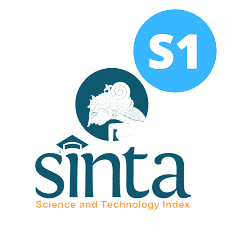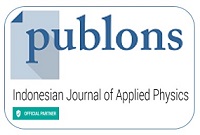Influence FF Concentration to Thermal Diffusivity in Liquid Form using Photopyroelectric (PPE) Setup and Dual-Beam Mode-Mismatched Thermal Lens Method with Different Optical Sensors
Abstract
Keywords
Full Text:
PDFReferences
[1] J. P. Gordon, R. C. C. Leite, R. S. Moore, S. P. S. Porto, and J. R. Whinnery, “Long-Transient Effects in Lasers with Inserted Liquid Samples,” J. Appl. Phys., vol. 36, no. 1, pp. 3–8, Jan. 1965, doi: 10.1063/1.1713919.
[2] R. Zamiri et al., “Thermal diffusivity measurement of silver nanofluid by thermal lens technique,” J. Laser Appl., vol. 23, no. 4, p. 042002, Nov. 2011, doi: 10.2351/1.3622205.
[3] E. Shahriari, M. Moradi, and M. Raeisi, “An experimental study of thermal diffusivity of Au nanoparticles: effects of concentration particle size,” J. Theor. Appl. Phys., vol. 10, no. 4, pp. 259–263, Dec. 2016, doi: 10.1007/s40094-016-0224-x.
[4] S. E. Bialkowski and A. Mandelis, “Photothermal Spectroscopy Methods for Chemical Analysis,” Phys. Today, vol. 49, no. 10, pp. 76–76, Oct. 1996, doi: 10.1063/1.2807813.
[5] J. Shen, A. J. Soroka, and R. D. Snook, “A model for cw laser induced mode-mismatched dual-beam thermal lens spectrometry based on probe beam profile image detection,” J. Appl. Phys., vol. 78, no. 2, pp. 700–708, July 1995, doi: 10.1063/1.360329.
[6] V. R. Khabibullin, L. O. Usoltseva, I. V. Mikheev, and M. A. Proskurnin, “Thermal Diffusivity of Aqueous Dispersions of Silicon Oxide Nanoparticles by Dual-Beam Thermal Lens Spectrometry,” Nanomaterials, vol. 13, no. 6, p. 1006, Mar. 2023, doi: 10.3390/nano13061006.
[7] D. P. Singh, C. E. Herrera, B. Singh, S. Singh, R. K. Singh, and R. Kumar, “Graphene oxide: An efficient material and recent approach for biotechnological and biomedical applications,” Mater. Sci. Eng. C, vol. 86, pp. 173–197, May 2018, doi: 10.1016/j.msec.2018.01.004.
[8] V. M. Lenart, N. G. C. Astrath, R. F. Turchiello, G. F. Goya, and S. L. Gómez, “Thermal diffusivity of ferrofluids as a function of particle size determined using the mode-mismatched dual-beam thermal lens technique,” J. Appl. Phys., vol. 123, no. 8, p. 085107, Feb. 2018, doi: 10.1063/1.5017025.
[9] L. G. Rodriguez, P. Iza, and J. L. Paz, “Study of dependence between thermal diffusivity and sample concentration measured by means of frequency-resolved thermal lens experiment,” J. Nonlinear Opt. Phys. Mater., vol. 25, no. 02, p. 1650022, June 2016, doi: 10.1142/S0218863516500223.
[10] K. Chen, “Advances in Perovskite Photodiodes: Material and Device Innovations,” J. Photonic Mater., vol. 15, no. 2, 2023.
[11] K. S. Novoselov and et. al., “Electric Field Effect in Atomically Thin Carbon Films,” Phys Rev Lett, vol. 404, 2000.
[12] E. M. Chua, J. Shimeta, D. Nugegoda, P. D. Morrison, and B. O. Clarke, “Assimilation of Polybrominated Diphenyl Ethers from Microplastics by the Marine Amphipod, Allorchestes Compressa,” Environ. Sci. Technol., vol. 48, no. 14, pp. 8127–8134, July 2014, doi: 10.1021/es405717z.
[13] A. B. Silva, A. S. Bastos, C. I. L. Justino, J. P. Da Costa, A. C. Duarte, and T. A. P. Rocha-Santos, “Microplastics in the environment: Challenges in analytical chemistry - A review,” Anal. Chim. Acta, vol. 1017, pp. 1–19, Aug. 2018, doi: 10.1016/j.aca.2018.02.043.
[14] W. I. Liu et al., “A novel comprehensive experimental study concerned graphene oxide nanoparticles dispersed in water: Synthesise, characterisation, thermal conductivity measurement and present a new approach of RLSF neural network,” Int. Commun. Heat Mass Transf., vol. 109, p. 104333, Dec. 2019, doi: 10.1016/j.icheatmasstransfer.2019.104333.
[15] J. L. Jiménez-Pérez, G. López-Gamboa, J. F. Sánchez-Ramírez, Z. N. Correa-Pacheco, A. Netzahual‑Lopantzi, and A. Cruz-Orea, “Thermal Diffusivity Dependence with Highly Concentrated Graphene Oxide/Water Nanofluids by Mode-Mismatched Dual-Beam Thermal Lens Technique,” Int. J. Thermophys., vol. 42, no. 7, p. 107, July 2021, doi: 10.1007/s10765-021-02861-6.
[16] J. John, L. Thomas, B. Rajesh Kumar, A. Kurian, and S. D. George, “Shape dependent heat transport through green synthesized gold nanofluids,” J. Phys. Appl. Phys., vol. 48, no. 33, p. 335301, Aug. 2015, doi: 10.1088/0022-3727/48/33/335301.
[17] R. Herrera-Aquino, J. L. Jiménez-Pérez, D. C. Altamirano-Juárez, G. López-Gamboa, Z. N. Correa-Pacheco, and R. Carbajal-Valdéz, “Green Synthesis of Silver Nanoparticles Contained in Centrifuged Citrus Oil and Their Thermal Diffusivity Study by Using Thermal Lens Technique,” Int. J. Thermophys., vol. 40, no. 1, p. 3, Jan. 2019, doi: 10.1007/s10765-018-2466-0.
[18] M. Ramya, T. K. Nideep, V. P. N. Nampoori, and M. Kailasnath, “Particle size and concentration effect on thermal diffusivity of water-based ZnO nanofluid using the dual-beam thermal lens technique,” Appl. Phys. B, vol. 125, no. 9, p. 181, Sept. 2019, doi: 10.1007/s00340-019-7294-9.
[19] Z. Cai, M. Tian, and G. Zhang, “Experimental Study on the Flow and Heat Transfer of Graphene-Based Lubricants in a Horizontal Tube,” Processes, vol. 8, no. 12, p. 1675, Dec. 2020, doi: 10.3390/pr8121675.
[20] J. Wilk, R. Smusz, R. Filip, G. Chmiel, and T. Bednarczyk, “Experimental investigations on graphene oxide/rubber composite thermal conductivity,” Sci. Rep., vol. 10, no. 1, p. 15533, Sept. 2020, doi: 10.1038/s41598-020-72633-z.
[21] Y. Hwang, Y. Heo, Y. Yoo, and J. Kim, “The addition of functionalized graphene oxide to polyetherimide to improve its thermal conductivity and mechanical properties: ENHANCED PROPERTIES OF THE FUNCTIONALIZED GO/PEI COMPOSITES,” Polym. Adv. Technol., vol. 25, no. 10, pp. 1155–1162, Oct. 2014, doi: 10.1002/pat.3369.
[22] P. Rutkowski, P. Klimczyk, L. Jaworska, L. Stobierski, and A. Dubiel, “Thermal properties of pressure sintered alumina–graphene composites,” J. Therm. Anal. Calorim., vol. 122, no. 1, pp. 105–114, Oct. 2015, doi: 10.1007/s10973-015-4694-x.
[23] W. Yu, H. Xie, and D. Bao, “Enhanced thermal conductivities of nanofluids containing graphene oxide nanosheets,” Nanotechnology, vol. 21, no. 5, p. 055705, Feb. 2010, doi: 10.1088/0957-4484/21/5/055705.
[24] K. Ramesh, J. Ponnusamy, and P. Periasamy, “Synthesis of Antimicrobial and Antioxidant Zinc Oxide Hydrogel for Drug Delivery Applications,” Indones. J. Chem., vol. 24, no. 6, p. 1615, Dec. 2024, doi: 10.22146/ijc.85663.
[25] M. R. Rodríguez-Laguna et al., “Mechanisms behind the enhancement of thermal properties of graphene nanofluids,” Nanoscale, vol. 10, no. 32, pp. 15402–15409, 2018, doi: 10.1039/C8NR02762E.
Refbacks
- There are currently no refbacks.
















